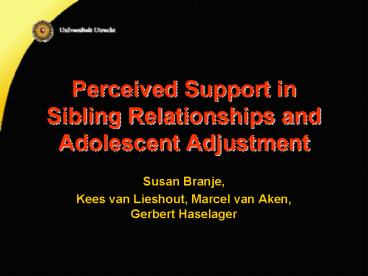Perceived Support in Sibling Relationships and Adolescent Adjustment
1 / 17
Title:
Perceived Support in Sibling Relationships and Adolescent Adjustment
Description:
Regression analyses: standardized betas and R2. Note: only significant betas are presented. ... standardized betas and R2. Note: only significant betas are ... –
Number of Views:65
Avg rating:3.0/5.0
Title: Perceived Support in Sibling Relationships and Adolescent Adjustment
1
Perceived Support in Sibling Relationships and
Adolescent Adjustment
- Susan Branje,
- Kees van Lieshout, Marcel van Aken, Gerbert
Haselager
2
Introduction
- Adolescents who perceive more support exhibit
less internalizing and externalizing problem
behaviors (e.g., Furman Holmbeck, 1995 Barrera
et al., 1993) - Mainly found for parental and friend support
- What is the role of sibling support and behavior
in adolescents adjustment?
3
Introduction
- More effects of older sibling on younger sibling
than vice versa - (e.g, Tucker et al, 1999 Slomkowski et al.
2001) - Modeling hypothesis
- Older siblings may serve as role models for
younger siblings - De-identification hypothesis
- Older siblings are more likely to de-identify
from their younger sibling - (Updegraff et al., 2000 McHale et al., 2001 )
4
Introduction
- Sibling support over time
- Relation sibling support and behavior with
adjustment - -control for demographic characteristics and
support parents and friend - Longitudinal effects sibling support and behavior
on adjustment - -control for adjustment problems t1
5
Hypotheses
- More support from older siblings than from
younger siblings - Older adolescents support towards their younger
sibling will be associated with less behavioral
problems of the younger sibling, but not vice
versa - The effect of older siblings will appear over
time and after controlling for support from
family and friends - The effect of older siblings will be present
mainly in same-sex sibling dyads
6
Method
- Family and Personality Project
- 3 waves 1997, 1998, 1999
- 271 families
- 2 children, mean age 14.5 and 12.3 (wave 1)
- fathers and mothers, mean age 43.9 and 41.7
- Sibling dyads 64 boy-boy, 71 boy-girl, 66
girl-boy, 72 girl-girl
7
Method
- Perceived relational support from sibling
- 27 5-point Likert scale items
- Relational Support Inventory, Scholte et al.,
2001 - Judgments by adolescents
- Problem behavior (Scholte, De Bruyn Vermulst)
- Internalizing problems anxiety and depression,
withdrawal - 9 5-point Likert scale items
- Externalizing problems aggression and
delinquency - 7 5-point Likert scale items
- Judgments by parents (average of father and
mother) and self
8
ResultsLatent Growth Curve Models
9
ResultsLatent Growth Curve Models
LGCs were estimated in multi-age-groups
(younger child 11, 12 and gt12 older
child 15, 14 and lt14)
10
Results
- Regression analyses standardized betas and R2
Note only significant betas are presented. P
lt.05 P lt.01
11
Results
- Regression analyses standardized betas and R2
Note only significant betas are presented. P
lt.05 P lt.01
12
Results
- Regression analyses standardized betas and R2
Note only significant betas are presented. P
lt.05 P lt.01
13
Results
- Regression analyses standardized betas and R2
Note only significant betas are presented. P
lt.05 P lt.01
14
Results
- sibling support related to self-reported
externalizing and internalizing behavior - after controlling for support from father,
mother, and friend - sibling problem behavior related to parent
reported externalizing behavior and self- and
parent reported internalizing behavior - over time
- externalizing behavior only effects of older
siblings support and behavior - internalizing behavior only effects of older
and younger siblings behavior reported by
parents
15
Conclusion
- Increase between 11 and 13 year of support
perceived from older siblings - From 13 years onwards, support from older
siblings and younger siblings was stable - Sibling support and behavior is related to
adolescent functioning - but depending on rater and type of problem
behavior - sibling support is negatively related to
externalizing problems - sibling problem behavior is stronger related to
internalizing problems
16
Conclusion
- No de-identification for older adolescents
- Adolescents relationships with both older
- and younger siblings are characterized by
- modeling or identification processes
17
(No Transcript)































